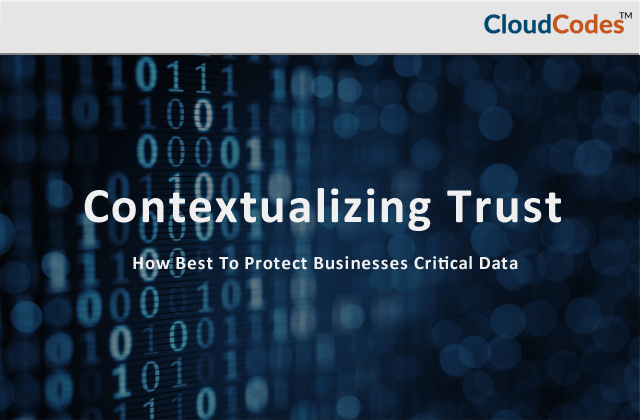What is Contextualize Trust?
The path forward is pretty clear – the huge rate in adoption of fine-grained, context-sensitive i.e. contextualize trust is the suitable method. Furthermore, this contextualizes trust design has to be employed in more than just user-based programs. It should be applied to every element that communicates with a machine and the system itself.
Nowadays companies have a big challenge in front of them, whose name is ‘crucial data security. It is not only for financial services and healthcare vendors but, also for those persons who freely share their personal data through the social network. The data wealth tracked by the IoT devices is just mind-boggling. If we go for a credit score scenario, there is a bulk of information that is out of our reach. In the year 2017, the data breach incident of credit reporting firm Equifax leaked the personal information of around 143 million American clients. Similarly, in September 2017, the biggest breach in the history of Facebook breach the personal data of around fifty million individuals. On the current date, even if you are off the grid, trust us when we inform you that in actuality ‘you are not off the grid’.
Provided the absence of proper choices for end-users, people assume themselves in an unenviable stage to have little option but, to believe organizations where their data is processed. Alike this, these same firms are also at the stage of trusting (or distrusting) those devices, employees, infrastructure, and systems, which create the entire IT environment. That’s already too much trust and is, in fact, a part of the challenge! While devices, machines, systems, and infrastructure could have their different agendas, weak points, and priorities, enterprises have manually colored with a fairly broad brush when it’s about contextualized trust. Here comes the major mistake! It is so because the trust could be powerful in our seek for safer, better, and more secure relationships between the vendor and consumer.
In an IT world, enterprises can begin by adopting a page from the playbook of government. Government firms have a large history with trust factor – one only has to observe at the clearance procedure, which validates the trustworthiness of those who use classified information and how classified information is isolated from the one who doesn’t process the necessity for access. Also, government officials know the requirement of balancing the two-phase concept of trustworthiness and risk acceptance. They know that this is part of using multi-stage security systems. In the majority of cases, this works well even against some detected external threats and malicious insiders. It’s simple to concentrate on the situation where the measure has broken down but, we also have to be attentive with several times it has attempted in the exact manner as designed.
Let’s Understand The Contextualize Trust With A Common Real Life Situation
Wait for a second, this particular framework also comprises some weak points! Trust is connected throughout but, only in the case of government bodies. The issue is the method we decontextualize the trust factor and that stems from the method we pretend to imagine about trust exceptionally in the internet world. When an individual meets someone on the social network and he or she is getting known to each other, that person can judge the trust level with the newly connected individual. This sort of trust is situational! You may trust your new friend for offering a ride to dinner but, not yet believe him or her with the keys to your car. It is not about identifying a human as good or bad but, whether they are suitable to attempt a specific operation reliably or not. For example – you may learn about someone who has completely good intentions but, very clumsy by nature. Of course, you may not trust this clumsy individual and don’t share secrets of your life, just an assumption, even though he or she is reliable, kind, and honest. This doesn’t mean that that new friend is bad; he or she is just bad with fragile aspects. It is a subtle but essential difference – it is not just about trusting someone but, trusting someone with respect in a particular situation.
Compare this Real-life Trust Scenario With Computing
Often, defenders enforce a high-degree of outside or inside thing with the statements of ‘what is outside is bad and what is inside is good. Once a person logged into a system or part of an industry, he or she is provided free rein within his or her privileged rights. Now just take an example – there are some balances and checks – an internal threat app tries to address those internal individuals who are dangerous for the company. However, the all-embracing paradigm is one of distrust or trust, with not much in between. It is the same with systems – once a system gets placed over the network, we usually trust it without zero doubts. This sort of trust is not at all complete trust because it’s not situational – it’s a more ‘deny or permit’ privilege-oriented system, which is simple for criminals to exploit. Most importantly, by decontextualizing the trust factor and mitigating it to an all-or-nothing score, we permit anyone who comes under the trusted domain to do their intended operation. The major challenge for an attacker is only to detect that one door in the network from where he or she can perform the cloud computing threat.
Trust Is Important But, It Should Be Contextualize Trust
The only available long-term idea for a data management solution is to adopt this architecture of contextualizing trust in a broad and consistent way. Going away from good or bad, inside or outside thoughts had already begun and this needs to be encouraged further. What is essentially needed is to address the trust level in terms of degrees and use this concept in the delivery of risk-adapting cloud data security standards.

